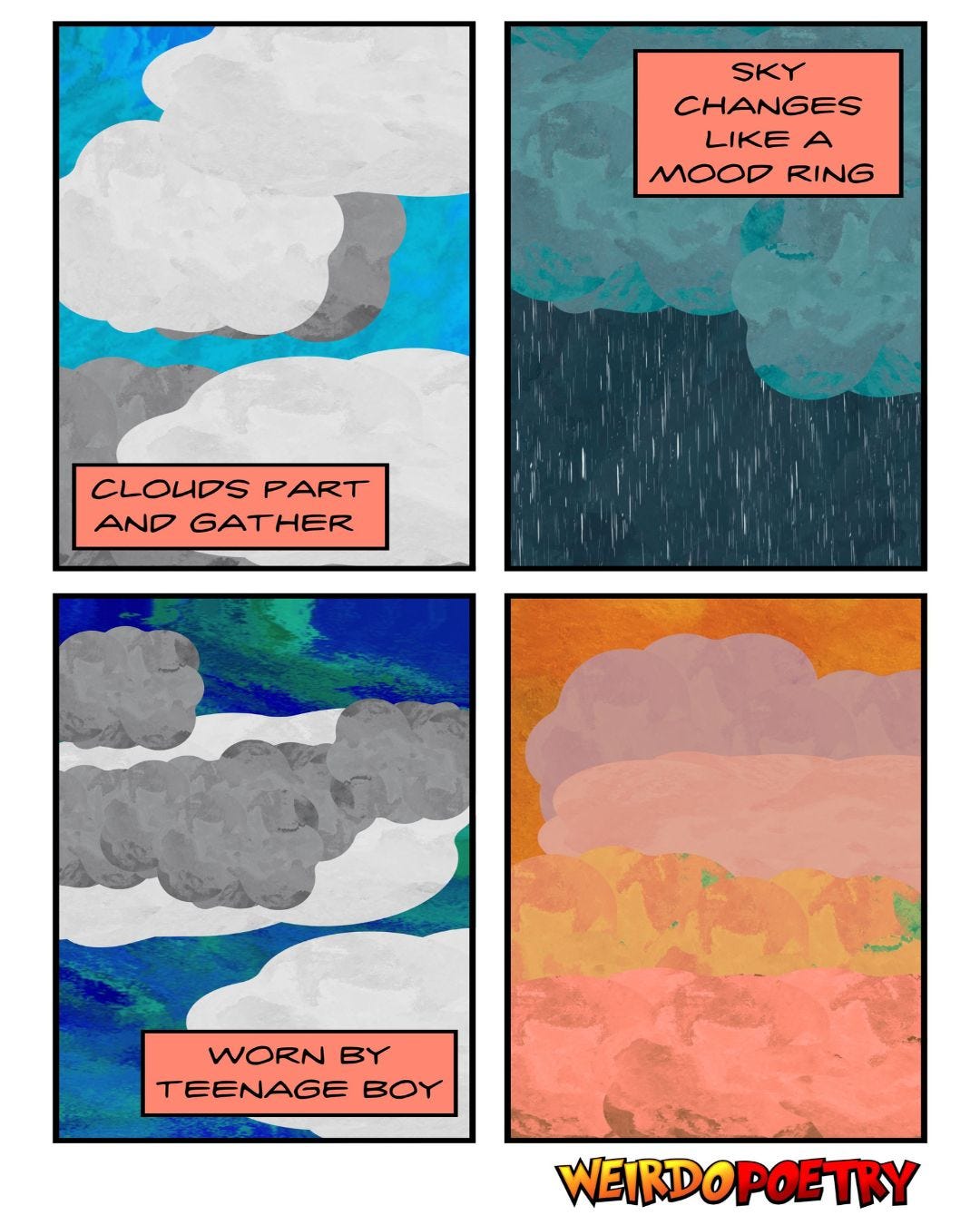Hello, Poets!
Last week,
suggested we talk about the concept of form, and there’s nothing I love more than geeking out about form in terms of constructing a haiku! Because of technical issues, today there is only audio for the haiku, not the essay.clouds part and gather sky changes like a mood ring worn by teenage boy
Putting the Right Words in the Right Spaces
Trying to figure out what the form of a haiku is has been one of the most rewarding challenges of my creative career—and I no longer think there is a single answer.
Japanese Haiku
Haiku has a long tradition in Japan and has evolved over the centuries.
In Japanese, the form of a haiku was traditionally a three-phrase poem written in one line with the first and third phrases having five syllables and the middle phrase having seven syllables. In addition to these requirements, haiku were expected to be about observations of nature, contain a seasonal word (kigo 季語), have one phrase that contains a cutting word1 (kireji 切れ字), and in later eras evoke a sense of wabi-sabi2 (侘寂).
However, as Hiroaki Sato shows repeatedly in his book On Haiku3, even the haiku masters that every haiku expert points to as the epitome of the form would write poems breaking from the 5-7-5 format and taking other liberties with the rules.
English Breaks Haiku
When haiku was introduced into English in the late 19th and early 20th centuries, poets and translators made some changes. In Japanese, wabi-sabi is closely tied to Zen Buddhism, and that sensibility was often overlooked. In English, haiku is traditionally written in three lines, and a lot of liberties are taken with the use of season words and cutting words.
Today, very few Japanese haiku are translated in the 5-7-5 format because translators realize that doing so robs these poems of the essence.
In schools, most English speakers are taught that haiku is a three-line poem about nature with the first and third lines having five syllables and the middle line having seven syllables. Haiku is often the first poetic form schoolchildren are taught. Because of this background, most English speakers don’t think about season words, cutting words, or wabi-sabi when writing haiku.
State of Modern English Language Haiku
Most modern English language haiku poets place no importance on syllable count, and instead focus almost exclusively on wabi-sabi, brevity, and season words, with cutting words only sometimes being used.
Many modern English haiku poetry journals look at poems that follow the 5-7-5, three-line format with disdain as being amateurish. However, haiku luminary, and Tricycle magazine haiku columnist Clark Strand, writes beautiful poems in this form.
In journals and haiku publications, three-line poems are used about 60% of the time,4 with poets using a variety of line and word configurations the rest of the time.
Allen Ginsburg would write haiku that were grammatically correct, 17-syllable sentences, written as one line.
Jack Kerouac called his haiku “pops”, and they were usually written in short, three-line bursts, never worrying about syllable count, but obsessed with the wabi-sabi aesthetic.
In Japanese, there is a related poetic form called senryu that focuses on the nature of human absurdity instead of nature, while using the 5-7-5 syllable convention.
English language haiku is a big umbrella that covers many, many variations in the form of haiku. I would argue that English doesn’t really have a senryu tradition and that these poems are thought of as haiku in English.
Any three-line poem following the 5-7-5 pattern, regardless of content, can be considered a haiku. There are wonderful collections of haiku about robots, the periodic table, the Twilight Zone5, and American history. I have written collections of pirate and horror haiku.
Any three-line poem that focuses on nature and brevity, regardless of syllable count, is also considered a haiku. English language haiku also includes any configuration of 17-syllable poems and poems of any syllable count hoping to capture the essence of the Japanese haiku in terms of season words, cutting words, and wabi-sabi.
I don’t believe there is anything to be gained from gatekeeping the notion of what is and is not a haiku. If you tell me a poem you have written is a haiku, I will believe you.
I think there is something to the idea that a true haiku can only be written in Japanese and that every English version of the haiku belongs under the separate, and quite broad, umbrella of English language haiku.
I don’t believe there is any uniform form for haiku. In my poetry, I write haiku in the three-line. 5-7-5 pattern because I love how these constraints boost my creativity and my goal is to try and convince as many people as possible to read and write poetry. Because English speakers are nearly universally familiar with this form, my poetry becomes instantly more accessible.
But, in my haiku comics, I vary from the three-line format. There, my primary goal is to provide a great reading experience, and the tight space of a comic panel requires I break up the lines a little differently.
Experiments in Form
However, just because I typically do something one way doesn't mean that it is the correct way. Like we did last week with punctuation, let’s look at some different ways today’s haiku could be written using different spacing and line breaks. These variations will be easiest to see in the online version of this post, and may not be fully conveyed in the email version.
Here is how I first wrote the haiku:
clouds part and gather sky changes like a mood ring worn by teenage boy
Here is how the poem looks in the comic:
clouds part and gather sky changes like a mood ring worn by teenage boy
Here is the poem as a single line:
Clouds part and gather, sky changes like a mood ring worn by teenage boy
Here is the same poem with a more artistic layout:
clouds part and gather sky changes like a mood ring worn by teenage boy
Another variation:
clouds part
and gather
sky changes
like a mood ring
worn by teenage boyMy general preference with my poetry is to prioritize readability. I’d rather the reader wrestle with my meaning than my presentation. But, I have to admit I enjoy the way the last two versions look on the page.
Haiku Prompt
Write a haiku, any kind of haiku, but do something different with the line breaks and/or word spacing. See what removing a three-line constraint does. Please share your work in the comments or tag me on Notes!
Be the poetry you want to see in the world!
Cheers,
Jason
Cutting words are essentially types of verbal exclamations that mark the end of a segment of a poem. There is a lot of nuance to how they are used, and often they signal a turn of the poem into an unexpected direction, almost like a twist at the end of a short story. This concept will have to wait for a future essay for a deeper exploration.
Wabi-sabi is the beauty of the imperfect and a sense of bittersweet acceptance of that imperfection. You can find my take on wabi-sabi in English language haiku in this post from September 7, 2023.
I love On Haiku, and one of these weeks I will be writing a deep dive into this wonderful book. It’s a great resource if you’re curious about the evolving nature of haiku and to learn how its ineffable nature continues to enchant poets all over the world.
This is my rough estimate based on my anecdotal reading. If anyone wants to sponsor a formal survey, I’d love to design a more accurate study. : )
I illustrated some haiku comics for Chad Boykin’s Twilight Zone Haiku website.







I LOVE that you’re reading your Haiku this week. If you’re tallying votes, mine is a loud “keep it up”! That 5-10 second recording adds so much to the experience at the beginning of your publication.
Also, some kudos, there is no doubt you are inspiring people to write more poetry.
Now, on to my full time job. I hope to spend some time with your prompt later this evening !
I loved seeing this transformation between what your first wrote and the haiku that followed. Sounds like you were going through some spiritual upheaval. I like the scripture vibe that carries through all of these poems. It’s a poignant lament